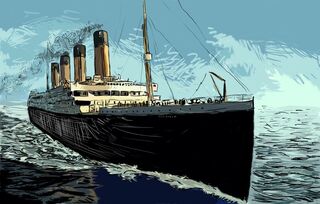Magical Thinking
We Will Go Down With This Ship
What the Titanic can teach us about facing hard truths.
Posted August 17, 2020

In 2020, there’s been much discussion around the idea that “we’re all in the same boat.” Some argue staunchly in favor of this inclusivity, while others argue that because of race, class, and gender differences, we very much are not in the same boat. But what happens when we get specific with this metaphor? Perhaps we are all on the same ship, the RMS Titanic, but just on different decks. While it might seem hyperbolic, it’s impossible to look around ourselves and not see the decline of our society—2020 is a time when even the Postal Service is in jeopardy. If you are struggling to see or understand your position in 2020, we invite you to use the skill of Therapeutic Fanfiction and envision yourself on the RMS Titanic. We know that for some of you, this metaphor might feel grim. Our intention here is to help you use the powers of your imagination to practice sitting with hard and uncomfortable truths.
The RMS Titanic was a marvel of human innovation, so impressed were her admirers that she was dubbed “unsinkable.” And this label caused complacency that led to magical thinking. All souls aboard believed the boat could not sink and so they were woefully unprepared. And so are we.
Similarly, the Western world has considered itself to be an unsinkable ship. And we have ignored all the warnings issued to us about looming icebergs. We are unsinkable, we believe, and these warnings do not apply to us. There is no more time for debate about whether or not the ship is unsinkable. We are sinking. We are taking on the waters of climate change and plague, the waters of hate and totalitarianism, and the waters of frigid cold shock. We must confront our magical thinking and acknowledge that it was and is a cognitive distortion.
Now we must act, but we do not all have the same amount of power to act. The Titanic has classes. First class is already nearest the boats, second class a few levels down, and third class (steerage) with the most people at the lowest levels of the ship. Pause for a moment and consider where you are on the metaphorical Titanic. Are you a first, second, or third class passenger? Or are you a member of the crew or staff? Consider the ways your race, class, and gender impact your social standing on the ship.
Wherever you are on the ship and whatever your role, there is one thing that you all have in common, you are on a sinking ship. Your ability to manage this however, depends on where you are in the social strata. First class are closer to the lifeboats, though some refuse to see the direness of the situation and refuse to move. Soon, however, reality will set in for all. As you continue to notice the reality of your surroundings, you can start to consider the choices available to you. Will you scramble to reach a lifeboat, or help others aboard? Will you dress in your finery and await your fate? Will you hold loved ones close? Will you offer words of kindness to others? Will you play music to help calm the nerves of the others around you? Or will you scramble in vain to make your way to the deck from your steerage quarters? If you are in the metaphorical First class, how are you creating a pathway for those in third class to get to the deck? Once you’ve created this image in your mind decide how you will use this knowledge to enact change on the SS 2020.


